水飞蓟素ppt课件
- 格式:ppt
- 大小:450.85 KB
- 文档页数:8
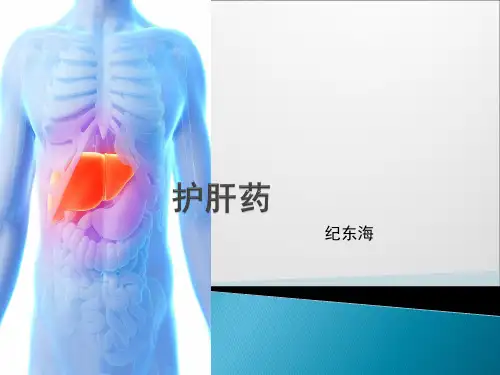
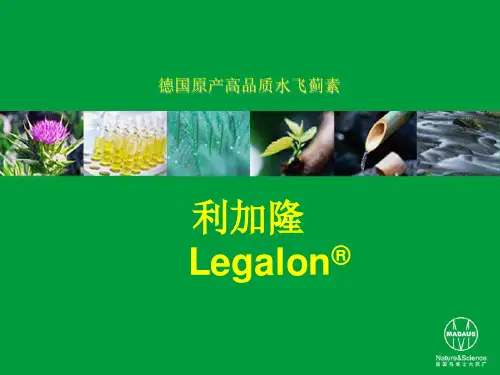
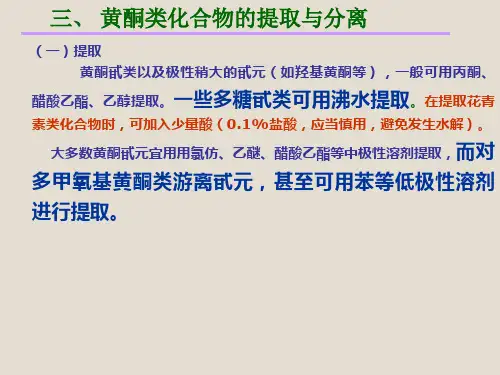
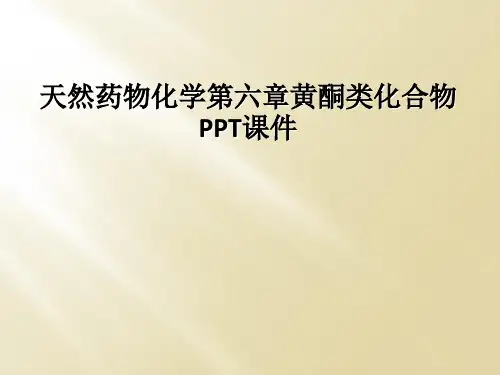
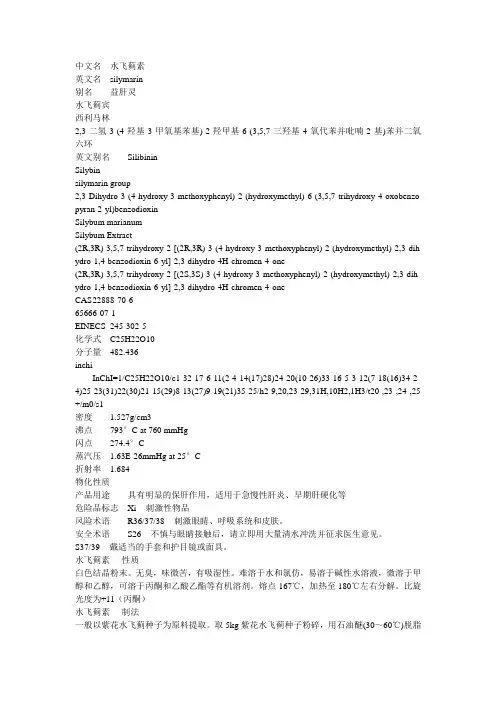
中文名水飞蓟素英文名silymarin别名益肝灵水飞蓟宾西利马林2,3-二氢-3-(4-羟基-3-甲氧基苯基)-2-羟甲基-6-(3,5,7-三羟基-4-氧代苯并吡喃-2-基)苯并二氧六环英文别名SilibininSilybinsilymarin group2,3-Dihydro-3-(4-hydroxy-3-methoxyphenyl)-2-(hydroxymethyl)-6-(3,5,7-trihydroxy-4-oxobenzo pyran-2-yl)benzodioxinSilybum marianumSilybum Extract(2R,3R)-3,5,7-trihydroxy-2-[(2R,3R)-3-(4-hydroxy-3-methoxyphenyl)-2-(hydroxymethyl)-2,3-dih ydro-1,4-benzodioxin-6-yl]-2,3-dihydro-4H-chromen-4-one(2R,3R)-3,5,7-trihydroxy-2-[(2S,3S)-3-(4-hydroxy-3-methoxyphenyl)-2-(hydroxymethyl)-2,3-dih ydro-1,4-benzodioxin-6-yl]-2,3-dihydro-4H-chromen-4-oneCAS 22888-70-665666-07-1EINECS 245-302-5化学式C25H22O10分子量482.436inchiInChI=1/C25H22O10/c1-32-17-6-11(2-4-14(17)28)24-20(10-26)33-16-5-3-12(7-18(16)34-2 4)25-23(31)22(30)21-15(29)8-13(27)9-19(21)35-25/h2-9,20,23-29,31H,10H2,1H3/t20-,23-,24-,25 +/m0/s1密度 1.527g/cm3沸点793°C at 760 mmHg闪点274.4°C蒸汽压 1.63E-26mmHg at 25°C折射率 1.684物化性质产品用途具有明显的保肝作用,适用于急慢性肝炎、早期肝硬化等危险品标志Xi - 刺激性物品风险术语R36/37/38 - 刺激眼睛、呼吸系统和皮肤。

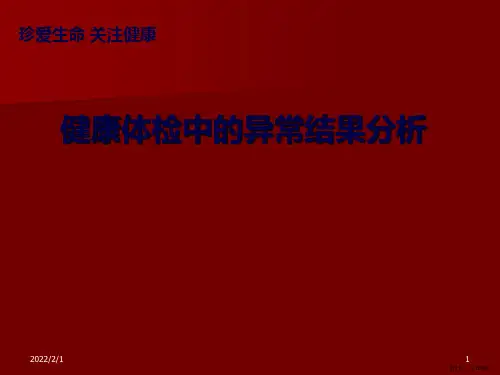


Journal of Chromatography B,945–946 (2014) 1–9Contents lists available at ScienceDirectJournal of ChromatographyBj o u r n a l h o m e p a g e :w w w.e l s e v i e r.c o m /l o c a t e /c h r o mbDevelopment and validation of two liquid chromatography–tandem mass spectrometry methods for the determination of silibinin and silibinin hemisuccinate in human plasmaFederica Sala a ,Pablo Albares b ,Milena Colovic a ,Stefano Persiani a ,∗,Lucio C.Rovati aa Rottapharm|Madaus,R&D Division,Monza,Italy bEurofins|ADME BIOANALYSES,Vergeze,Francea r t i c l ei n f oArticle history:Received 9July 2013Accepted 17November 2013Available online 25 November 2013Keywords:SilibininSilibinin hemisuccinate HPLC–MS/MS ValidationPharmacokineticsa b s t r a c tTo investigate the pharmacokinetics of silibinin and silibinin hemisuccinate in human plasma,two high-performance liquid chromatography–tandem mass spectrometry (HPLC–MS/MS)methods were developed and validated.The methods require a small volume of sample (100L),and the recovery of the analytes was complete with a good reproducibility (CV%1.7–9.5),after a simple protein precipitation.Naringenin was used as internal standard.The chromatographic methods provided a good separation of diastereoisomers A and B of both silibinin and silibinin hemisuccinate onto a Chromolith Performance RP18e 100mm ×3mm column,with a resolution of peaks from plasma matrix in less than 6min.The methods precision values expressed as CV%were always ≤6.2%and the accuracy was always well within the acceptable 15%range.Quantification was performed on a triple-quadrupole tandem mass spectrome-ter by Selected Reaction Monitoring (SRM)mode,in a negative ion mode,via electrospray ionization (ESI).The lower limit of quantitation was set at 5.0ng/mL (silibinin)and 25.0ng/mL (silibinin hemisuccinate),and the linearity was validated up to 1000.0and 12,500.0ng/mL,for silibinin and silibinin hemisucci-nate,respectively,with correlation coefficients (R 2)of 0.991or better.The methods were suitable for pharmacokinetic studies and were successfully applied to human plasma samples from subjects treated intravenously with Legalon ®SIL at the dose of 20mg/kg,expressed as silibinin.© 2013 Elsevier B.V. All rights reserved.1.IntroductionThe diastereoisomers silibinin A and B (Fig.1,part A and B),collectively called silibinin,represent the main constituents of sily-marin,extracted from milk thistle (Silybum marianum )fruits,and the first oral drug to treat toxic and chronic non-viral liver dis-ease.Silibinin showed,in both in vitro and in vivo experiments,anti-hepatotoxic,anti-oxidative and anti-fibrotic properties [1–5].Moreover,it was shown that silibinin could surprisingly inhibit death of animals when intoxicated by Amanita mushroom poison-ing [6–8].Based on such extraordinary findings,a hydrosoluble dihydrogen succinate ester of silibinin,silibininin hemisuccinateAbbreviations:ACD,acid citrate dextrose;HCV,hepatitis C virus;IFN,interferon;MF,matrix factor;MP,mobile phase;NMF,normalized matrix factor;SOC,standard of care;SRM,selected reaction monitoring;TNF,tumor necrosis factor;UHQ,ultra high quality.∗Corresponding author at:Rottapharm|Madaus,Via Valosa di Sopra 9,20900Monza,Italy.Tel.:+390397390396.E-mail address:stefano.persiani@ (S.Persiani).(Fig.1,part C and D),was developed for an intravenous infusion therapy of patients who suffered from acute potentially deadly Amanita phalloides mushroom poisoning.Silibinin hemisuccinate for intravenous use is today registered or licensed in several countries under the name Legalon ®SIL (Rottapharm|Madaus,Monza,Italy)for the treatment of acute hepatic failure following Amanita phalloides intoxication.Its first marketing authorization was in 1984and the recommended dose of silibinin hemisuc-cinate for mushroom poisoning is 20mg/kg daily,expressed as silibinin,in four 5mg/kg infusions until resolution of the clinical signs of intoxication [9].The precise mechanism of action of silib-inin hemisuccinate against amatoxins is still not totally elucidated.Silibinin may exert its effects at several levels as it has been shown to:inhibit the binding of amatoxin to hepatocyte membranes [10];compete with amatoxin for trans-membrane transport [11,12];interrupt biliary secretion and thus enterohepatic recirculation of amatoxin [13];inhibit TNF-␣release in damaged hepatocytes [14];stimulate protein synthesis in damaged liver cells [15,16].In recent years,Legalon ®SIL has been shown to be a potent antiviral agent against HCV both in vitro [17,18]and in patients with chronic viral hepatitis C (HCV)infection1570-0232/$–see front matter © 2013 Elsevier B.V. All rights reserved./10.1016/j.jchromb.2013.11.0282 F.Sala et al./J.Chromatogr.B 945–946 (2014) 1–9Fig.1.Chemical structures of silibinin A (part A),silibinin B (part B),silibinin hemisuccinate A (part C)and silibinin hemisuccinate B (part D).who did not respond or were only sub-optimally responding to standard of care (SOC)therapy with pegylated interferon plus ribavirin [19–22].The recommended dose of silibinin hemisuccinate in chronic HCV is 20mg/kg daily,expressed as sili-binin,in a single infusion for up to 40days.The antiviral effects of silibinin hemisuccinate are the result of a dual mode of action.On the one hand antiviral properties of silibinin are due to the host cellular level,mediated partly by induction of Stat 1phosphorylation which activates intracellular IFN-induced pathways,and partly by IFN-independent mechanisms like for instance inhibition of the 5-lipoxygenase pathway [23].On the other hand,data from virologic experiments prove that silibinin can directly inhibit HCV replication and functions [17,24],without selecting for resistance [25,26].At present,silibinin hemisuccinate is being further developed for the treatment of acute liver failure caused by Amanita mush-room intoxication [27]and in reducing the risk of HCV re-infection after orthotopic liver transplantation in chronic hepatitis C patients and for the treatment of patients that do not respond or respond incompletely to SOC [28,29].These newly discovered antiviral properties of silibinin/silibinin hemisuccinate are clinically relevant because they indicate that an intravenous infusion therapy with Legalon ®SIL might fulfill these urgent therapeutic needs.Several clinical studies have been planned and are ongoing to better characterize its therapeutic potential.Therefore,it is fundamental to develop and validate assays that can accurately quantify silibinin and silibinin hemisuc-cinate diastereoisomers in human plasma for proper PK analyses.To the best of our knowledge,no method is yet available to measure silibinin hemisuccinate in human plasma,whereas several methods have been developed for silibinin analysis,but they were not fully validated [30,31]or they were not able to individually quantify the two diastereoisomers [32,33]or they are based on demanding sam-ples’preparation [34].Consequently,two new,precise and simple HPLC–MS/MS methods were validated to investigate the pharma-cokinetics of silibinin and silibinin hemisuccinate in human plasma.The methods require a small volume of sample (100L)and offer a complete recovery of the analytes after a simple protein precip-itation.High selectivity and sensitivity are guaranteed by working in the Selected Reaction Monitoring (SRM)mode.The methods were successfully applied to samples collected during a pharma-cokinetic study conducted in healthy male volunteers receiving anintravenous single administration of Legalon ®SIL infused within 4h at the dose of 20mg/kg expressed as silibinin.2.Materials and methods2.1.Standards and chemicalsAnalytical reference standard of silibinin (isomer A and B),as well as the internal standard naringenin,was supplied by Sigma–Aldrich (St.Louis,MO).Whereas analytical reference standard of trans silibinin hemisuccinate (isomer A and B)was obtain from Euromed (Mollet del Vallès,Spain).Analytical grade methanol and acetonitrile were purchased from SDS (Carlo Erba Reactifs,Val de Reuil,Cedex,France).Formic and acetic acids were obtained from Merck (New Jersey,USA).Ammonium acetate was supplied by Fisher Scientific (Loughborough,UK)and sodium acetate was purchased from Sigma–Aldrich.Ultra High Quality (UHQ)water was obtain from Eurofins|ADME Bioanalyses (Vergèze,France).Control human plasma from sodium citrate blood,used to prepare daily standard calibration curves and quality control sam-ples (QCs),was obtained from volunteers.2.2.Standard and quality control solutionsSilibinin,silibinin hemisuccinate and naringenin standard solu-tions were prepared at the concentration of 1.0mg/mL in methanol,in a dark flask and taking into account the respective corrective fac-tors.The isomer A concentration was expressed according to the ratio between the two isomers A and B contained in the reference standard.Working solutions necessary to prepare the standard points of the calibration curve and those necessary to prepare the plasma quality control samples were obtained by diluting different amounts of stock solution with methanol to obtain silibinin and silibinin hemisuccinate at the final concentrations reported below:Silibinin concentration (g/mL)=0.05,0.15,0.5,1,1.25,2.5,5,8,10,50and 100.Silibinin hemisuccinate concentration (g/mL)=0.25,0.75,6.25,12.5,25,62.5,100,125and 200.F.Sala et al./J.Chromatogr.B945–946 (2014) 1–93The internal standard(IS)working solution was prepared at0.02 and at0.04g/mL by diluting the stock solution with0.1%acetic acid in acetonitrile.All these solutions were freshly prepared daily.2.3.Preparation of standards and quality control samplesIn a1.5mL polypropylene tube,10L of the appropriate diluted solution of silibinin and silibinin hemisuccinate were added to 100L of control human plasma to obtain eight calibration stan-dards in the range5.0–1000.0ng/mL and25.0–12,500.0ng/mL, respectively.To prepare QC samples,control human plasma was mixed with an appropriate amount of QC solutions obtaining QC plasma samples at thefinal concentration of5.0,15.0,125.0,500.0and 800.0ng/mL for silibinin,and25.0,75.0,6250.0and10,000.0ng/mL for silibinin hemisuccinate.Aliquots were frozen at−80◦C and were used to check the stability under storage conditions and after freeze/thaw cycles.2.3.1.Samples preparationPlasma samples(110L QC and standards,100L study sam-ples+10L MeOH)were mixed with20L of sodium acetate1.5M (pH5)and were added with600L of the internal standard solution at0.02g/mL for silibinin analysis and at0.04g/mL for silibinin hemisuccinate analysis.After vortexing for1min,the plasma sam-ples were centrifuged for5min at14,000rpm between0and9◦C. Then,600L of the supernatant was transferred in a polypropylene tube and dried under a nitrogen stream at approximately45◦C.The dried residue was reconstituted with200L of42:58ammonium acetate(pH3.5,5mM):methanol/0.1%formic acid in UHQ water (90/10),vortexed for30s and transferred in a96-well plate.Before the injection onto the LC–MS/MS system,samples were centrifuged for5min at3500rpm between0and9◦C.2.4.Chromatographic conditionsThe HPLC system consisted of a LC-20AD,which included an automatic sampler(SIL-20AC)and a column oven(CTO-20AC),Shi-madzu(Kyoto,Japan).Silibinin and silibinin hemisuccinate A and B were separated onto a Chromolith Performance RP18e100mm×3mm(Merck, Billerica,MA,USA)maintained at40◦C.The mobile phases(MP) consisted of0.1%formic acid in UHQ water(MP A)and in methanol (MP B)and an isocratic program was applied to silibinin analyses. In particular,the separation of silibinin A and B was obtained with 62%MP A and38%MP B at aflow rate of1mL/min,whereas the separation of silibinin hemisuccinate A and B was reached at aflow rate of0.8mL/min.The analysis of silibinin hemisuccinate was in isocratic mode at50%MP A,but with the addition of a gradient wash step to clean the column between every injection.The chro-matographic conditions were:step1–50%MP A for7min;step 2–from50%MP A to2%in0.1min;step3–constant conditions for2.9min;step4–from2%MP A to the initial conditions over 0.1min;initial condition kept for3min.The total run time was7min for silibinin isomers and13min for silibinin hemisuccinate isomers.The samples,kept at4◦C,were injected onto the column and were then introduced into the mass spectrometer.2.5.Mass spectrometryThe HPLC system was coupled with an API4000(AB Sciex, Framingham,MA,USA)triple quadrupole mass spectrometer equipped with an electrospray ionization(ESI)interface,operating in negative ion mode.Detection was optimized setting an ion-spray voltage of−4200V and a source temperature of600and450◦C for silibinin and silibinin hemisuccinate,respectively.Collision acti-vated dissociation gas(CAD)was set at4,the curtain gas(CUR)at 25and nebulizer and heater gas(GS1and GS2)werefixed,respec-tively,at50and60for both analytes.For the analysis of samples, the mass spectrometer operated in the Selected Reaction Moni-toring mode(SRM),allowing the[M−H]−of silibinin and silibinin hemisuccinate(m/z481and681,respectively)to pass through the first quadrupole into the collision cell.After fragmentation,the characteristic product ions of the two compounds were monitored in the third quadrupole at m/z301for silibinin and at m/z463for silibinin hemisuccinate.The transitions monitored for the internal standard naringenin were m/z271>151and271>119.For each transition,the declustering and entrance potential(DP and EP),the collision energy(CE)and the collision cell exit potential(CXP)were optimized.SRM captures and integrations of chromatographic peak area were performed using Analyst software,version1.5.1(AB Sciex, Framingham,MA,USA),whereas concentrations calculation and data analysis were performed using Watson7.2.0.03(Thermo Elec-tron Corporation,Waltham,MA,USA).2.6.Validation study2.6.1.Recovery and matrix effectThe recovery of silibinin and silibinin hemisuccinate was eval-uated in six replicates at three different plasma concentrations: 3×LLOQ,0.5×ULOQ and0.8×ULOQ.The results obtained from the extracted samples and from pure solutions were compared.The recovery of internal standard was evaluated in the same way.The influence of the matrix effect on silibinin and silibinin hemisuccinate was assessed on six different batches of human plasma.Dry plasma extracts were reconstituted with200L of pure standard solutions,corresponding tofinal concentrations at3×LLOQ,0.5×ULOQ and0.8×ULOQ for silibinin and silibinin hemisuccinate.The signal obtained was compared to that obtained with pure standard solutions injected six times onto the chromato-graphic system.The mean area obtained was used for calculation. The quantitative measure of matrix effect(matrix factor,MF)is defined as the ratio of the analyte peak area in the presence of matrix ions to the analyte peak area in the absence of matrix ions.A MF of1corresponds to a lack of matrix effect;a value of less than 1suggests ionization suppression and a MF greater than1may be due to an ionization enhancement.The normalized matrix factor (NMF)was calculated as following:NMF=(analyte peak area/IS)in matrix/(analyte peak area/IS)in pure solution.2.6.2.Calibration curvesThe linearity of calibration curves was validated on three differ-ent occasions.Each curve comprised a blank human plasma,a blank human plasma spiked with IS(zero standard plasma sample,not included in the calibration calculation)and eight calibration stan-dards.The concentration–response relationship was determined through standard curves performed with a least squared linear regression and1/X2weighting.2.6.3.Precision,accuracy and LLOQThe intra-and inter-run precision and accuracy were evaluated on three different days by determining in sextuplet silibinin and silibinin hemisuccinate at the nominal QC concentrations of LLOQ, 3×LLOQ,0.5×ULOQ and0.8×ULOQ.The precision of the method at each concentration was reported as a coefficient of variation (CV%),expressing the standard deviation as a percentage of the mean calculated concentration;the accuracy of the measure was determined by expressing the percentage ratio of the absolute4 F.Sala et al./J.Chromatogr.B945–946 (2014) 1–9difference of the determined concentration from the theoretical one,and the theoretical value(deviation of accuracy%).The lower limit of quantitation(LLOQ)was defined as the low-est amount of the analyte that can be determined in a sample with sufficient degree of precision and accuracy(within20%for both parameters).The silibinin and silibinin hemisuccinate methods were developed and validated to investigate their pharmacoki-netic profile in human plasma;therefore appropriate concentration ranges were chosen andfixed at their lowest end as the LLOQ.2.6.4.StabilityThe stability of silibinin and silibinin hemisuccinate was assessed by analyzing QC samples at concentrations of3×LLOQ and 0.8×ULOQ.The stability of silibinin and silibinin hemisuccinate in human plasma extracts,kept between0and9◦C(autosampler sta-bility),was checked by re-analyzing,respectively,the processed samples74and82h after thefirst injection.The bench top plasma stability was determined after2h(silibinin)and1.5h(silibinin hemisuccinate)at room temperature and unprotected from light, and the freeze/thaw stability was measured after three freeze and thaw cycles.For each QC level,a series of six plasma samples had been stored at−80◦C for at least24h and left unattended for thaw-ing at room temperature.When completely thawed,the samples were frozen again for more than12h.The freeze and thaw cycle was repeated two more times and then the samples were analyzed. In addition,long term stability of silibinin and silibinin hemisucci-nate was assessed in plasma after storage at−80◦C and in stock solution at4◦C.The compounds were considered stable when the differences between the freshly prepared samples and the stability testing samples were found to be not exceeding15%deviation.Furthermore,in order to evaluate the stability of silibinin and silibinin hemisuccinate ex vivo in samples,several human plasma samples collected during the clinical study were reanalyzed in a separate analytical session.2.6.5.Dilution testingIn anticipation of the need to dilute samples falling outside the concentration range of the calibration curve,diluted QC sam-ples were prepared and analyzed.Six human plasma samples were spiked with silibinin and silibinin hemisuccinate at one concen-tration level above the ULOQ concentration(5000.0ng/mL and 12,500.0ng/mL,respectively)and they were diluted approximately 10-fold and50-fold with blank matrix before analysis.2.7.Clinical studyThe analytical methods were developed and validated to assess the pharmacokinetics of silibinin and silibinin hemisuccinate after a single intravenous administration of Legalon®SIL(Rot-tapharm|Madaus,Monza,Italy)infused within4h in six healthy male volunteers at the therapeutic dose of20mg/kg expressed as silibinin,and participating in a randomized,open-label,crossover study performed at Eurofins|Optimed Clinical Research(Gières, France).The study was approved by the local ethics committee and was conducted in accordance with the current revision of the Decla-ration of Helsinki concerning medical research in human.Written informed consent to participate was obtained by each participant.To determine the plasma concentrations of silibinin and silib-inin hemisuccinate and to study the pharmacokinetic profile,blood samples were collected into polypropylene tubes containing ACD (acid citrate dextrose)solution.The time points for4h intravenous infusion were:pre-dose,0.08,0.25,0.5,1,1.5,2,2.5,3,3.5,4,4.08, 4.25,4.5,5,7,10,13,16,20and24h.Within30min following blood collection,each blood sample was centrifuged at1500×g for 10min at4◦C.Immediately after the centrifugation,the top layer of human plasma was transferred into three different polypropylene tubes and frozen at−80◦C until analysis.Silibinin A and B and silibinin hemisuccinate A and B con-centrations were calculated using Watson7.2.0.03directly from chromatograms after integration by Analyst 1.5.1.The phar-macokinetic analysis was carried out using Kinetica®,version 4.3(Thermo Electron Corporation,Philadelphia,USA).The maxi-mum plasma concentration(C max)was obtained directly from the plasma concentration–time data and the area under the plasma concentration–time curve from time0to the last time point(AUC t) was calculated according to the linear trapezoidal rule.3.Results and discussion3.1.HPLC–MS/MSRepresentative SRM chromatograms of a blank plasma sample, a zero standard plasma sample(blank plasma spiked with IS)and a LLOQ sample both for silibinin and silibinin hemisuccinate are shown in Fig.2.No interfering peaks from endogenous substances appeared in the chromatograms.The developed methods allowed the separation of the two diastereoisomers of silibinin(A and B)and silibinin hemisuccinate (A and B).The retention times were3.6and4.2min for silibinin A and B,respectively;whereas the retention times for silibinin hemisuccinate A and B were,respectively,4.1and4.6min.The importance of this separation is the possibility to integrate and quantify each diastereoisomer,allowing the study of their different pharmacokinetic properties.The optimal conditions for analyte detection were achieved in negative ion mode:silibinin,silibinin hemisuccinate and the internal standard,naringenin,were monitored at the following mass-to-charge ratios(m/z)of[M−H]−:481,681and271,respec-tively.Then,the collision energy was optimized to obtain the product ions with the highest signal(m/z301,463,151,respec-tively).Product ion mass spectra of each analyte and of IS are presented in Fig.3,along with their respective supposed daughter ion chemical structures.3.2.Validation study3.2.1.Recovery and matrix effectThe analytical methods involved a simple protein precipitation that allowed a complete recovery of all analytes:silibinin A and B, silibinin hemisuccinate A and B and naringenin.The results obtained from the extracted samples and from pure solutions,in six replicates at three different concentrations, injected on to the chromatographic system,were compared.The extent of recovery was consistent,precise and reproducible across human plasma batches.As shown in Table1,the recovery was com-plete,with good reproducibility in the range2.5–5.8%(expressed as CV%),for silibinin A and B and in the range5.4–9.5%for sili-binin hemisuccinate A and B.The mean recovery of naringenin was105.9±1.8%during silibinin analysis and109.2±3.0%during silibinin hemisuccinate analysis.As shown in Table2,no significant ion suppression or enhance-ment was observed for the analytes and IS.Precision results of silibinin A and B,silibinin hemisuccinate A and B and IS were always lower than10%and the normalized matrix factor was approxi-mately1,demonstrating that the IS effectively corrects for matrix effect and variability,and is suitable as an IS.3.2.2.Calibration curvesCalibration curves were determined by plotting the concentra-tions versus analyte-to-IS peak area ratio and were found to beF.Sala et al./J.Chromatogr.B945–946 (2014) 1–95Fig.2.Representative SRM chromatograms of human blank plasma during silibinin analysis(part A)and during silibinin hemisuccinate analysis(part B);SRM chromatograms of naringenin at concentration of0.02g/mL(part C)and at concentration of0.04g/mL(part D);representative SRM chromatograms of silibinin(part E)and silibinin hemisuccinate(part F)at LLOQ concentration.linear within the range5.0–1000.0ng/mL for silibinin A and B, and within the range25.0–12,500.0ng/mL for silibinin hemisuc-cinate A and B,with a mean coefficient of determination(R2) of0.9953(range:0.9908–0.9994).The accuracy during silibinin analyses was in the range0.01to−3.69%and the precision was in the range0.39–5.43%when expressed as CV%.The accuracy dur-ing silibinin hemisuccinate analyses was in the range0.09–4.14% and the precision was7.08–10.56%.6 F.Sala et al./J.Chromatogr.B 945–946 (2014) 1–9Fig.3.Product ion spectra in negative ion mode of silibinin hemisuccinate (part A),silibinin (part B)and naringenin (part C)along with the supposed chemical structures of the monitored product ions.3.2.3.Precision,accuracy and LLOQThe repeatability and reproducibility of the analytical methods were demonstrated through the analysis of six replicates at three different concentrations,during a single run analysis for intra-day study and over three consecutive runs for inter-day determination.The precision and accuracy results are summarized in Table 3.Forsilibinin analysis,the intra and inter-day precision were less than 6.2and 5.5%,respectively,whereas for silibinin hemisuccinate anal-ysis the values were,respectively,less than 3.4and 4.8%.The intra and inter-day deviation of accuracy were less than 10.9and 8.9%,and less than 14.2and 8.4%,respectively,for silibinin and silibinin hemisuccinate.F.Sala et al./J.Chromatogr.B945–946 (2014) 1–97Table1Recovery of silibinin(A and B),silibinin hemisuccinate(A and B)and naringenin from human plasma.Analyte concentrations(ng/mL)Recovery%(mean,n=6)±SD CV%Silibinin A13.64113.6±6.0 5.3 454.70106.8±2.7 2.5 727.52101.6±4.7 4.6 Silibinin B15.00107.5±5.9 5.5 500.00105.2±4.2 4.0 800.00100.6±5.8 5.8 Silibinin hemisuccinate A69.30117.6±8.57.2 5775.00112.6±6.1 5.4 9240.00112.9±6.2 5.5 Silibinin hemisuccinate B75.00120.2±11.49.5 6250.00117.2±9.48.0 10,000.00114.1±7.3 6.4 Naringenin20.00105.9±1.8 1.7 40.00109.2±3.0 2.7The LLOQ wasfixed at5.0ng/mL for silibinin and at25.0ng/mL for silibinin hemisuccinate and was validated during three differ-ent runs by six replicates of human plasma spiked with the working solution.The precision and the accuracy for silibinin were,respec-tively,10.8and4.6%(isomer A),and10.2and3.7%(isomer B), whereas the precision for silibinin hemisuccinate was4.1and5.2%, respectively,for isomer A and isomer B.The accuracy for silibinin hemisuccinate A and silibinin hemisuccinate B was,respectively, 4.8and5.3%.3.2.4.StabilityStability data are presented in Tables4and5.The autosampler stability has been demonstrated allowing re-injection of an analyt-ical run up to74(silibinin)and82h(silibinin hemisuccinate)after sample processing.Silibinin(A and B)and silibinin hemisuccinate (A and B)were stable in fresh human plasma at room temperature for,respectively,2and1.5h.Human plasma samples containing silibinin hemisuccinate A and B,and silibinin A were stable afterTable2Normalized matrix factor(NMF)of silibinin(A and B),silibinin hemisuccinate(A and B)and naringenin in human plasma.Analyte concentrations(ng/mL)Mean NMF(n=6)±SD CV%Silibinin A13.64 1.07±0.098.5 454.70 1.01±0.03 3.2 727.52 1.02±0.02 2.1 Silibinin B15.00 1.04±0.05 5.0 500.000.99±0.03 2.9 800.00 1.00±0.03 3.2 Silibinin hemisuccinate A69.300.97±0.07 6.7 5775.00 1.02±0.06 5.9 9240.00 1.08±0.08 6.9 Silibinin hemisuccinate B75.000.97±0.088.6 6250.00 1.03±0.05 5.0 10,000.00 1.10±0.087.5 Naringenin20.00 1.09±0.10a8.940.00 1.15±0.02a 2.1a MF,matrix factor.Table3Intra-and inter-day accuracy and precision of the method for quantitative determi-nation of silibinin(A and B)and silibinin hemisuccinate(A and B).Analyteconcentrations(ng/mL)Intra-day(n=6)Inter-day(n=18)Dev.ofaccuracy%Precision%Dev.ofaccuracy%Precision%Silibinin A13.6410.9 5.58.1 5.5454.70−0.3 1.0−1.0 3.4727.52 2.4 4.3−1.0 4.7Silibinin B15.0010.3 6.28.9 5.0500.000.6 1.80.5 3.3800.00 3.2 3.80.6 4.3Silibinin hemisuccinate A69.3014.2 2.58.4 4.85775.008.2 1.4 2.7 4.69240.00 1.8 2.6−2.3 4.2Silibinin hemisuccinate B75.00 6.8 3.4 5.7 2.86250.000.1 1.4−0.2 2.610,000.00−4.6 2.1−4.8 3.2three freeze(−80◦C)and thaw(room temperature)cycles,whereas silibinin B was not stable after three freeze/thaw cycles.Therefore, no reanalysis could be performed on the same plasma aliquot for silibinin B.Long term stability of silibinin(A and B)and silibinin hemisuc-cinate(A and B)in human plasma was validated,respectively,up to,34and64days after freezing at−80◦C,whereas the stock solu-tions of silibinin and silibininin hemisuccinate in methanol were demonstrated to be stable upon storage at0–9◦C for,respectively, 18and31days.In addition,the stability of the compounds was also evaluated ex vivo in human plasma samples collected during the clinical study. The reanalysis showed that,whereas silibinin B was not stable, silibinin A,silibinin hemisuccinate A and B were stable in ex vivo samples stored at−80◦C for14months,because,in more than80% of plasma samples,the difference between original concentration and reassay concentration was within20%.3.3.Clinical samplesFig.4shows the plasma concentration–time profiles of silibinin A,silibinin B,silibinin hemisuccinate A and silibinin hemisuc-cinate B determined by the present method in a healthy male volunteer following a4-h infusion of Legalon®SIL at the dose of 20mg/kg(expressed as silibinin).Plasma samples analysis occurred within the validated long-term stability period of all compounds. The mean C max and AUC t values were characterized by low inter-subjects variability(expressed as SD),as shown by the following data(N=6):C max(g/mL):0.4±0.1(silibinin A);0.05±0.02(silibinin B);55.0±7.9(silibinin hemisuccinate A);28.3±3.9(silibinin hemisuccinate B).AUC t(g/mL h): 2.1±0.8(silibinin A);0.3±0.1(silibinin B); 210.7±42.5(silibinin hemisuccinate A);86.2±14.6(silibinin hemisuccinate B).The results showed that Legalon®SIL administered via a4h infusion produced silibinin and silibininin hemisuccinate plasma concentrations that were within the validated analytical ranges。

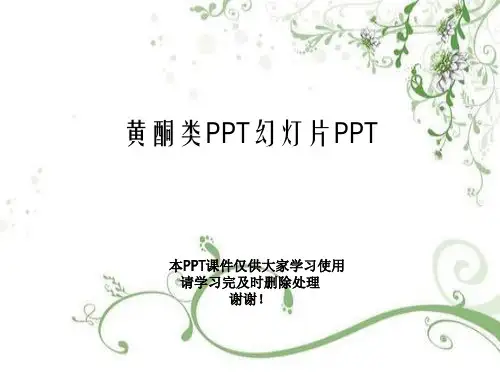
水飞蓟素的化学成分及药理作用研究进:通过查阅近年来有关天然药物水飞蓟的活性成分———水飞蓟素的化学成分及其药理学的研究报道,进行提炼和总结。
对水飞蓟素的化学成分及其提取工艺和药理作用的研究进展进行综述。
标签:水飞蓟素化学成分水飞蓟宾药理作用水飞蓟(silybum marianum L.Gaertn),是菊科水飞蓟属草本植物,原产于南欧、北非[1]。
水飞蓟是欧洲民间的一种草药,用于治疗肝胆疾病。
我国早在20世纪50年代初就引入了水飞蓟,但仅用于观赏,直到20世纪60年代末以H.Wagner 为代表的德国药学家,对其有效成分进行提取后,我国才将它作为一种保肝药用植物推广种植。
水飞蓟素(silymarin)是从水飞蓟种子中提取的一种新型黄酮类化合物,是一种淡黄色粉末状物质,主要成分有水飞蓟宾(silybin)、异水飞蓟宾(isosilybin)、水飞蓟宁(silydianin)、水飞蓟亭(silychristin)等[2]。
其中,以水飞蓟宾含量最高,活性也最强。
它具有保肝[2]、降血脂、抗氧化[3]、防止糖尿病[4]、保护心肌、抗血小板聚集和抗肿瘤[5]等生理作用。
本文仅就近年来国内外在水飞蓟素主要成分、药理作用方面的研究状况综述如下。
1化学成分研究1.1黄酮类化合物水飞蓟种子中含有大量的黄酮类化合物,主要为水飞蓟素。
水飞蓟素是水飞蓟宾(Silybin)、聚水飞蓟宾(Silybinomer)、水飞蓟亭(Silychristin)、水飞蓟宁(Silydianin)等化合物的总称。
其中,以水飞蓟宾含量最高。
1975年,竹本常松等从水飞蓟种子中获得了除上述水飞蓟宾异构体外,还有两种新的黄酮醇木脂体。
经红外、紫外、核磁等分析,确定结构为2,3-脱氢水飞蓟亭和2,3-脱氢水飞蓟宾[6]。
此外,还含有槲皮素、水飞木质灵、水飞木宁、黄烷木脂体、5,7-二羟基色酮[7]、多羟基苯并二氢吡喃-4-酮(polyhydroxyphenylchromanone)。